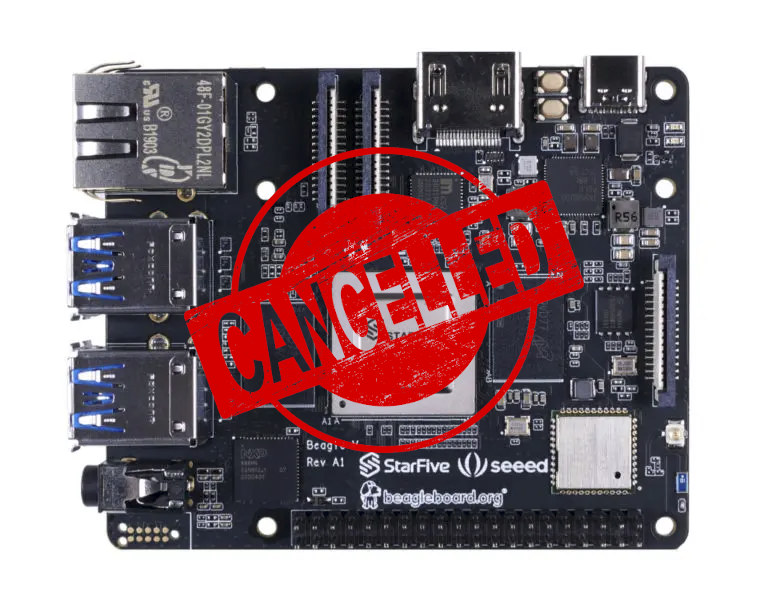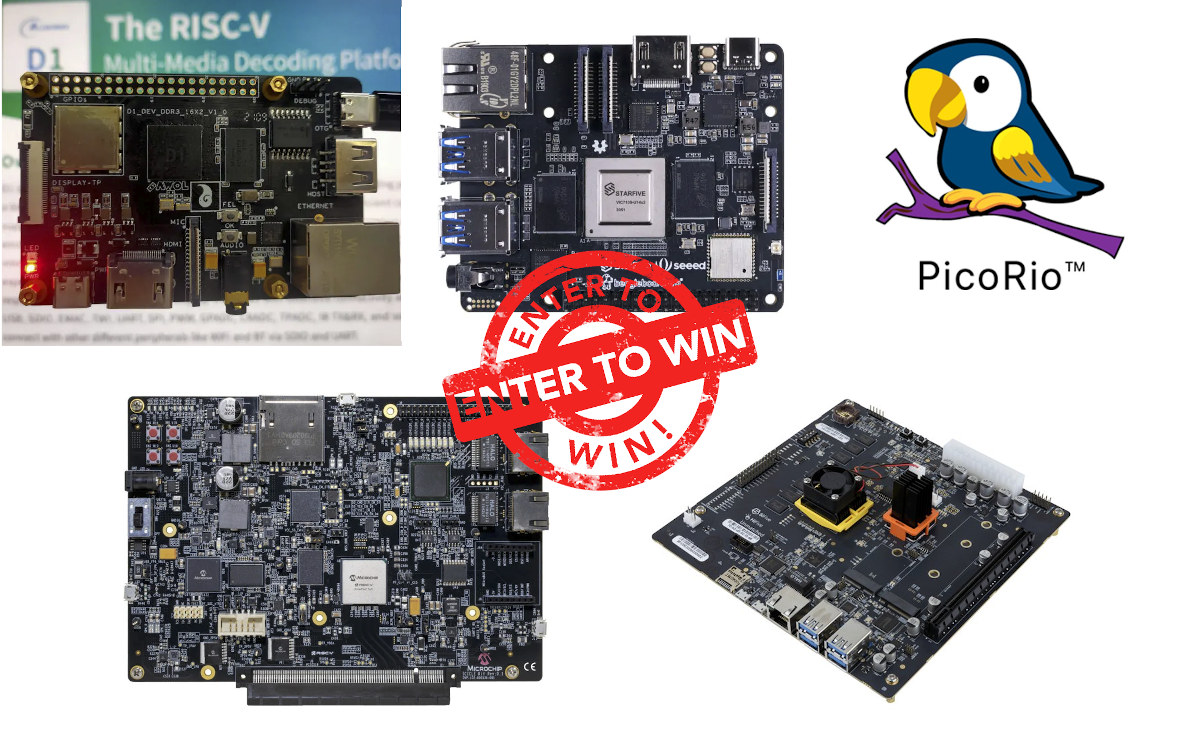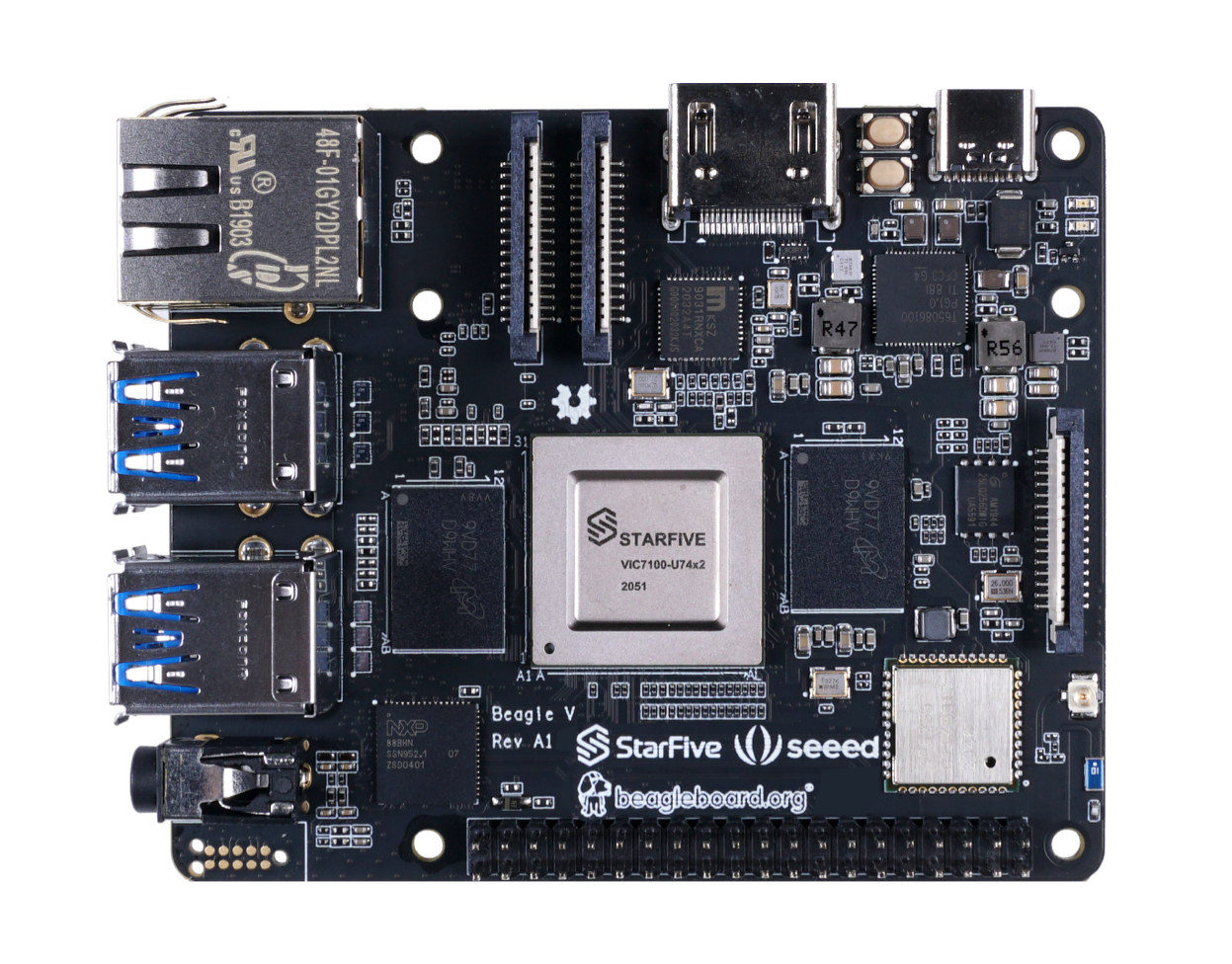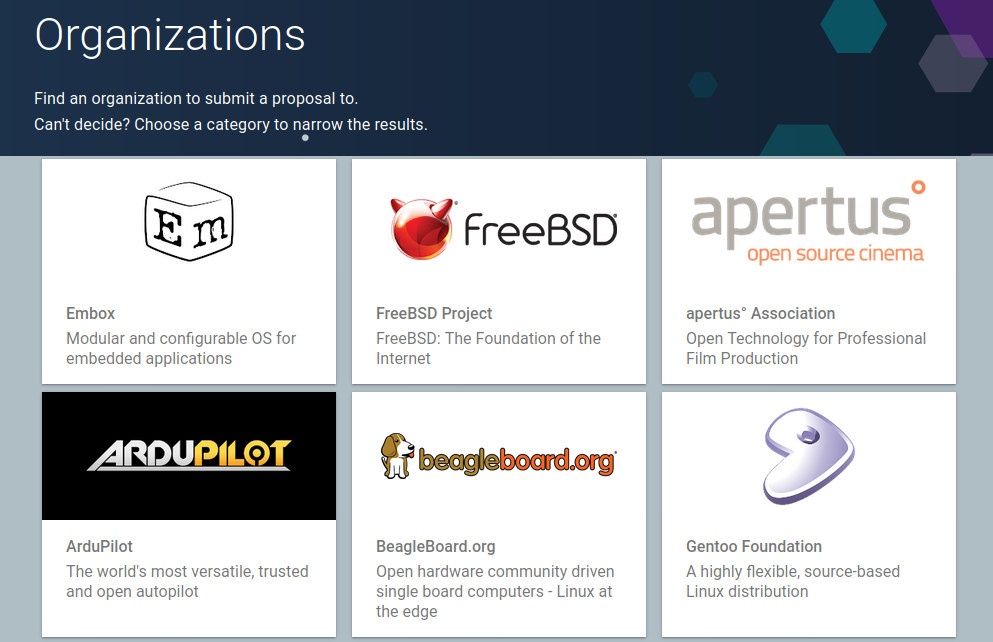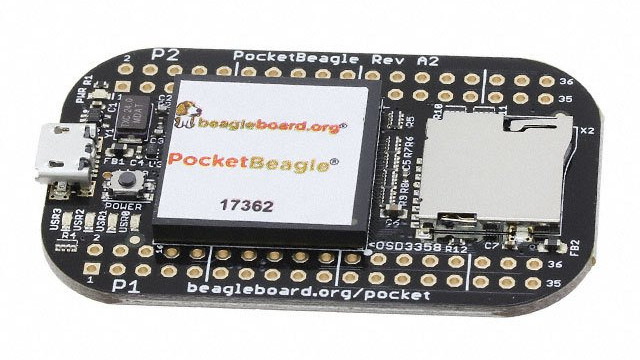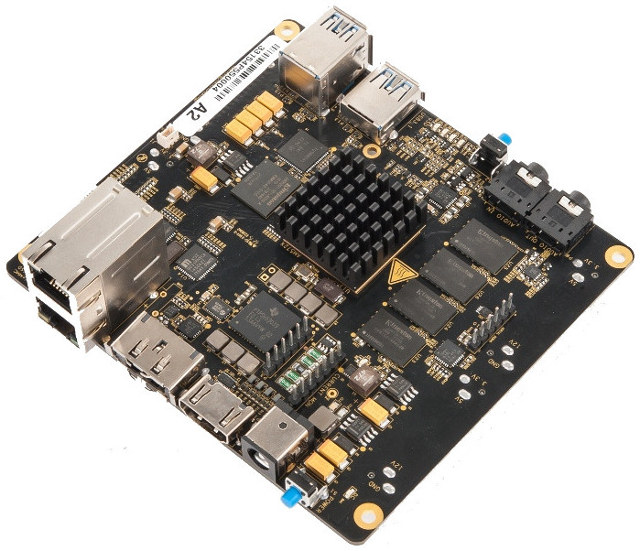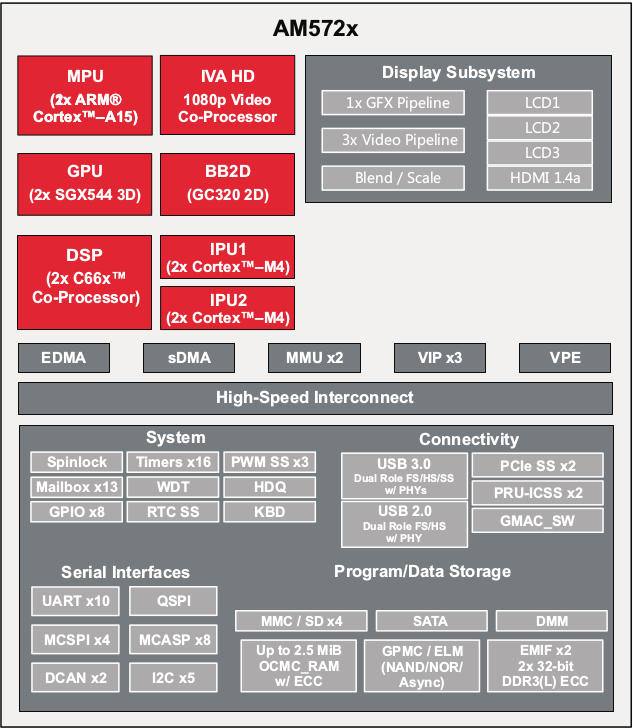There was lots of excitement when BeagleV Starlight single board computer was announced in January of this year. With a price tag of $119 and up, it promises to be an affordable RISC-V SBC with StarFive JH7100 dual-core SiFive U74 Vision SoC with AI accelerator, H.265/H.264 hardware video decoding, up to 8GB RAM, HDMI output, Gigabit Ethernet, and so on. Several beta testers even received BeagleV Startlight prototypes, providing instructions for buildroot, boot Linux, or even a video review with Fedora. The first version lacked a GPU, and the initial schedule planned for a new revision with an Imagination GPU to be manufactured in September. But there have been some changes, as BeagleV Starlight SBC will not go into mass production, but not all is lost, as the Foundation and Seeed Studio are working on a new BeagleV community board slated to be released in Q1 2022. Drew Fustini made […]
RISC-V International to give away 1,000 RISC-V development boards
The best way for a new platform to get good software support is to bring hardware into the hands of developers. That’s exactly what RISC-V International is doing by inviting developers to sign up for a RISC-V developer board sponsored by RISC-V and contributing members. There are 1,000 boards on offer with 1GB to 16GB RAM depending on the target project from five companies and organizations namely Allwinner, Beagleboard.org, SiFive, Microchip Technology (previously Microsemi), and RIOS. Here are the stated goals of the giveaway: Spur innovation Enable new opportunities for the next generation of developers to work with the RISC-V ISA Provide a platform For testing To write programs that run on RISC-V Develop software Integrate existing software stacks Optimize ecosystem software Share feedback on the product such as ease to integrate software stacks, develop and test extensions, etc. The company did not provide an exact list of development board […]
$119+ BeagleV powerful, open-hardware RISC-V Linux SBC targets AI applications
Running Linux on RISC-V hardware is already possible, but you’d have a choice of low-end platforms like Kendryte K210 that’s not really practical for anything, or higher-end board like SiFive HiFive Unmatched or PolarBerry for which you’d have to spend several hundred dollars, or even over one thousand dollars to have a complete system. So an affordable, usable RISC-V Linux SBC is clearly needed. We previously wrote about an upcoming Allwinner RISC-V Linux SBC that will be mostly useful for camera applications without 3D GPU, and a maximum of 256MB RAM. But today, we have excellent news, as the BeagleBoard.org foundation, Seeed Studio, and Chinese fabless silicon vendor Starfive partnered to design and launch the BeagleV SBC (pronounced Beagle Five) powered by StarFive JH7100 dual-core SiFive U74 RISC-V processor with Vision DSP, NVDLA engine, and neural network engine for AI acceleration. BeagleV specifications: SoC – StarFive JH7100 Vision SoC with: […]
Google Summer of Code 2020 Mentoring Organizations Announced
Every year Google organizes the Summer of Code inviting students to work on open-source projects and even get paid for it. The company first select mentoring organizations, before accepting applications from students. Google has now announced the 200 organizations/projects that have been selected for Summer of Code 2020. Many projects are higher-level software development such as web development or desktop programs development but there are also projects closer to the hardware-side of things with operating systems and multimedia projects. Some interesting organization and/or projects part of the audio / graphics / video / multimedia category include: apertus Association developing AXIOM open-source hardware camera FFmpeg multimedia framework to decode, encode, transcode, de/mux, stream, filter & play audio and video stream found in many projects OpenCV Open Source Computer Vision Library for computer vision and deep learning applications. XOrg foundation for X Window System and related projects such as Mesa, DRI, Wayland, […]
$25 PocketBeagle is a mini BeagleBone Board based on Octavo OSD3358-SM SiP
Earlier this year, Qwerty Embedded designed PocketBone board, an Eagle & KiCad open source hardware board software compatible with BeagleBone, but much smaller and based on Octavo OSD3358 system-in-package. This was never an official BeagleBoard.org board, and AFAIK it was not made broadly available. But the BeagleBoard foundation has now introduced PocketBeagle with a similar form factor, but based instead on the latest Octavo OSD3358-SM SiP that embeds TI Sitara AM3358, 512MB RAM, a PMIC, and various passive components into a 21×21 package, and exposing more I/Os thanks to 72 through holes. PocketBeagle board specifications: SiP (System-in-Package) – Octavo Systems OSD3358-SM with TI Sitara AM3358 ARM Cortex-A8 processor @ up to 1 GHz, PowerVR SGX530 GPU, 2x PRU, ARM Cortex-M3 for power and security management functions 512MB DDR3 800 MHz 4kB I2C EEPROM TPS65217 PMIC + LDO with integrated 1-cell LiPo battery support Storage – micro SD slot USB – […]
BeagleBoard-X15 Board Based on TI Sitara AM5728 SoC Announced, To Sell for $239
We’ve first found out about Beagleboard-X15 open source hardware board about a year ago, and development has taken a bit longer than expected, but Beagleboard.org has now formally launched BeagleBoard-X15, which remains based on Texas Instruments Sitara AM5728 dual Cortex A15 processor, and is expected to ship before Christmas for $239. The key part of the specifications are still the same as last year, but we’ve got a few more details now: SoC – Texas Instruments Sitara AM5728 with: Two ARM Cortex A15 cores @ 1.5 GHz PowerVR SGX544-MP2 3D GPU, Vivante GC320 2D GPU Two Cortex M4 cores @ 212 MHz Dual core C66x DSP @ 700 MHz IVA (Image and Video Accelerator) for 1080p video decode (H.264, VC-1, MPEG 1/2/4, AVS, etc..) Four 32-bit PRUs (Programmable Real-time Units) System Memory – 2GB DDR3L @ 533MHz Storage – 4GB 8-bit eMMC flash, micro SD slot, and eSATA interface (500 […]
BeagleBoard-X15 Development Board To Feature TI Sitara AM5728 Dual Core Cortex A15 Processor
Before the BeagleBone and BeagleBone Black boards based on TI Sitara processor, there were BeagleBoard (-xM) boards powered by TI OMAP3 processors, and Beageboard.org and Texas Instruments are now working on their next open source hardware board with BeagleBoard-X15 powered by TI Sitara AM572 dual core Cortex A15 SoC. Since Beagleboard-X15 has not been formally announced, there’s no picture, and we don’t have the full details yet, but here are the expect technical specifications: SoC – Texas Instruments Sitara AM5728 dual core Cortex A15 processor @ 1.5 GHz, with PowerVR SGX544-MP2 3D GPU, Vivante GC320 2D GPU, 2x Cortex M4 cores, dual core C66x DSP, and IVA (Image and Video Accelerator) for 1080p video decode (H.264, VC-1, MPEG 1/2/4, AVS, etc..) System Memory – 2GB DDR3L with dual 32-bit buses Storage – 4GB eMMC, micro SD slot, and eSATA interface Video I/O – HDMI out up to 1080p60, LCD port, […]
Embedded Linux Conference 2013 Schedule
The Embedded Linux Conference (ELC 2013) will take place on February 20 – 22, 2013 at Park 55 Hotel in San Francisco, California. ELC consists of 3 days of presentations, tutorials and sessions. There will be over 50 sessions during those 3 days. I’ll highlight a few sessions that I find particularly interesting, and that did not get presented at ELCE 2012 (AFAICR). February 20 11:00 – Anatomy of the arm-soc git tree by Olof Johansson, Google We are now two years into the new maintainer model for ARM platforms, and we have settled down into a workflow that maintainers have adjusted well to. Still, when new platforms arrive, or when maintainer ship changes hands, there’s sometimes a bit of ramp-up in getting used to how we organize our git tree and how we prefer to see code submitted to fit that model. This presentation will give an overview of […]


